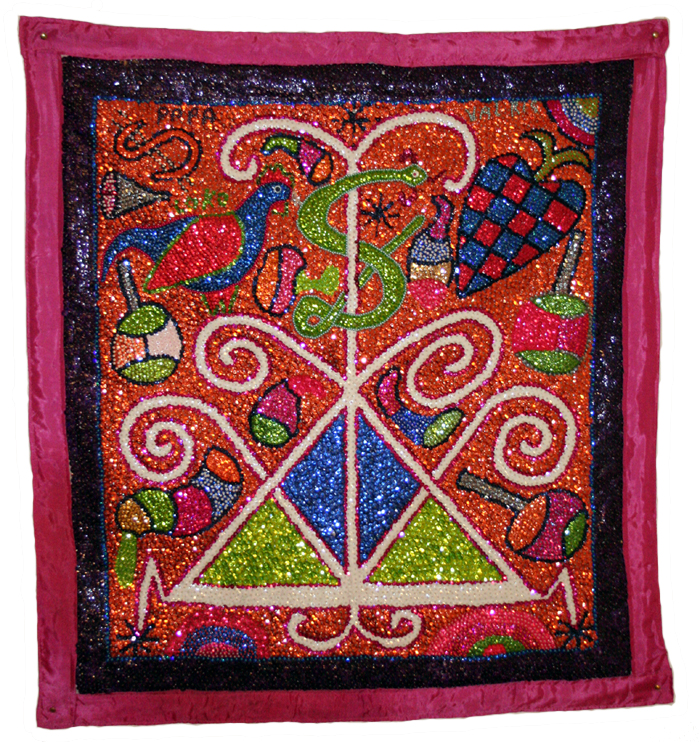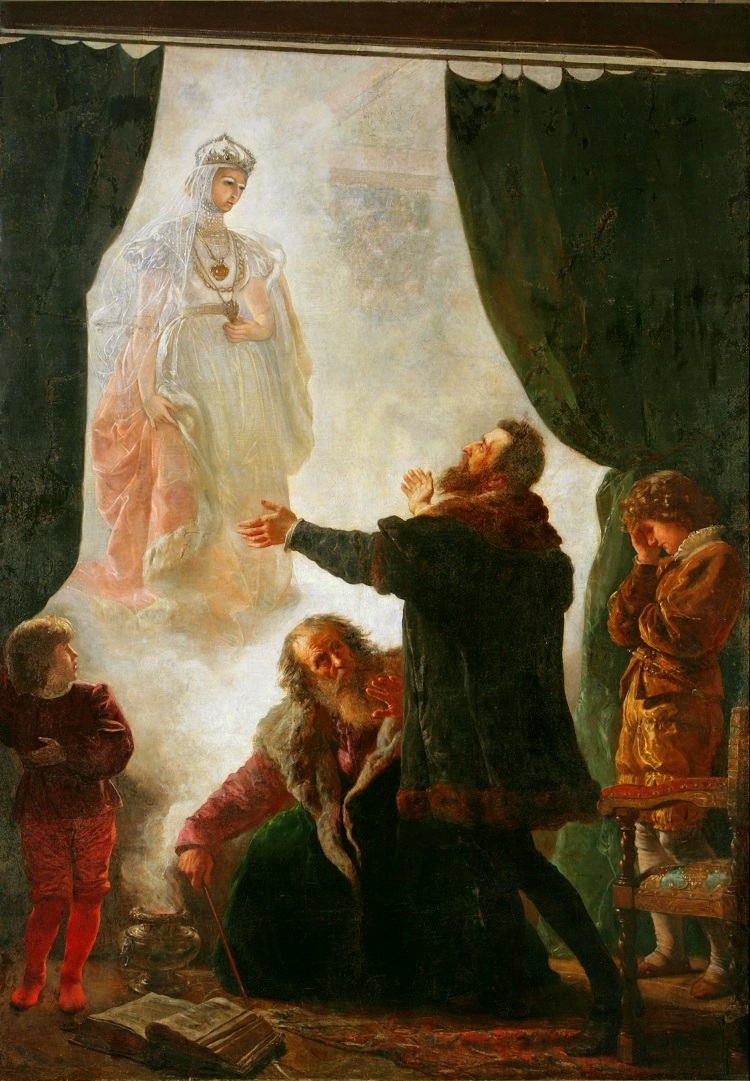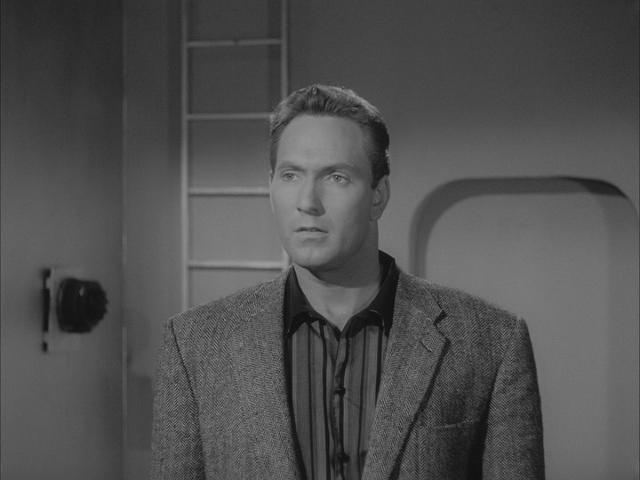|
Voodoo In Popular Culture
Voodoo in popular culture encompasses various representations of practices associated with different forms of voodoo, including Haitian Vodou and Louisiana Voodoo, and other elements attributed to African diaspora religions, with such representations often deviating substantially from any actual voodoo practices or beliefs. Tropes regarding voodoo appear most often in Supernatural fiction, supernatural fantasy or horror films, with common themes including the activity of witch doctors, the summoning or control of dark spirits, use of voodoo dolls to inflict pain on people remotely, and the creation of zombies. Background The word "Vodou" comes from the Fon language (spoken in Dahomey) meaning "spirit" or "god". As the original practice of Haitian Vodou, tribes would worship the spirits of ancestors and believed that followers were possessed by immortal spirits. During the seventeenth century, these practices were banned by slave owners, causing the slaves to practice in private. Sl ... [...More Info...] [...Related Items...] OR: [Wikipedia] [Google] [Baidu] |
Haitian Vodou
Haitian Vodou is an African diasporic religion that developed in Haiti between the 16th and 19th centuries. It arose through a process of syncretism between several traditional religions of West and Central Africa and Roman Catholicism. There is no central authority in control of the religion and much diversity exists among practitioners, who are known as Vodouists, Vodouisants, or Serviteurs. Vodou revolves around spirits known as '' lwa.'' Typically deriving their names and attributes from traditional West and Central African divinities, they are equated with Roman Catholic saints. The lwa divide up into different groups, the ''nanchon'' ("nations"), most notably the Rada and the Petwo. Various myths and stories are told about these lwa, which are regarded as subservient to a transcendent creator deity, Bondye. This theology has been labelled both monotheistic and polytheistic. An initiatory tradition, Vodouists usually meet to venerate the lwa in an ''ounfò'' (temple), run ... [...More Info...] [...Related Items...] OR: [Wikipedia] [Google] [Baidu] |
Victor Halperin
Victor Hugo Halperin (August 24, 1895 in Chicago, Illinois – May 17, 1983 in Bentonville, Arkansas) was an American stage actor, stage director, film director, film producer, producer, and writer. The majority of his works involved romance film, romance and horror film, horror. His brother, with whom he collaborated, was producer Edward Halperin (May 12, 1898 – March 2, 1981). Biography Victor Halperin began his career as a filmmaker in 1922, working as a writer on ''The Danger Point'' (an original story). In two years, he was working as a writer-producer-director on the Agnes Ayres film, ''When a Girl Loves''. He is best known for his 1932 horror film ''White Zombie (film), White Zombie'', starring Madge Bellamy and Bela Lugosi. Once thought "lost", the film has grown in stature over the years, first gaining a cult status, and eventually becoming recognized as one of the leading classics of the genre. Years after the film's release, Victor Halperin expressed a distaste f ... [...More Info...] [...Related Items...] OR: [Wikipedia] [Google] [Baidu] |
Undead
The undead are beings in mythology, legend, or fiction that are deceased but behave as if alive. Most commonly the term refers to corporeal forms of formerly-alive humans, such as mummies, vampires, and zombies, who have been reanimated by supernatural means, technology, or disease. In some cases (for example in Dungeons & Dragons) the term also includes incorporeal forms of the dead, such as ghosts. The undead are featured in the belief systems of most cultures, and appear in many works of fantasy and horror fiction. The term is also occasionally used for real-life attempts to resurrect the dead with science and technology, from early experiments like Robert E. Cornish's to future sciences such as "chemical brain preservation" and "cryonics." History Bram Stoker considered using the title, ''The Un-Dead'', for his novel '' Dracula'' (1897), and use of the term in the novel is mostly responsible for the modern sense of the word. The word does appear in English before Stoker ... [...More Info...] [...Related Items...] OR: [Wikipedia] [Google] [Baidu] |
Haitian French
Haitian French (french: français haïtien, Haitian Creole: ''fransè ayisyen'') is the variety of French spoken in Haiti. Haitian French is close to standard French. It should be distinguished from Haitian Creole. Phonology The phoneme consonant // is pronounced [], but it is often silent in the syllable coda when occurring before a consonant or prosodic break (''faire'' is pronounced [ː]). The nasal vowels are not pronounced as in French of France, // → [], // → [], // → [], and // → []. The typical vowel shifts make it sound very much like other regional accents of the French West Indies, French Caribbean and the Francophone countries of Africa. The perceivable difference between Haitian French and the French spoken in Paris lies in the Haitian speaker's intonation, where a subtle creole-based tone carrying the French on top is found. Importantly, these differences are not enough to create a misunderstanding between a native Parisian speaker and a speaker of Hai ... [...More Info...] [...Related Items...] OR: [Wikipedia] [Google] [Baidu] |
Culture Of Haiti
The culture of Haiti is an eclectic mix of African, Taino and European elements due to the French colonization of Saint Domingue and its large and diverse enslaved African population, as is evidenced in the Haitian language, music, and religion. Art Brilliant colors, naïve perspective, and sly humor characterize Haitian art. Big, delectable foods and lush landscapes are favorite subjects in this land. Going to market is the most social activity of country life, and figures prominently into the subject matter. Jungle animals, rituals, dances, and gods evoke the African past. Artists paint in fable as well. People are disguised as animals and animals are transformed into people. Symbols take on great meaning. For example, a rooster often represents Aristide and the red and blue colors of the flag of Haiti, often represent his Lavalas party. Many artists cluster in 'school' of painting, such as the Cap-Haïtien school, which features depictions of daily life in the city, th ... [...More Info...] [...Related Items...] OR: [Wikipedia] [Google] [Baidu] |
Zombies
A zombie (Haitian French: , ht, zonbi) is a mythological undead corporeal revenant created through the reanimation of a corpse. Zombies are most commonly found in horror and fantasy genre works. The term comes from Haitian folklore, in which a ''zombie'' is a dead body reanimated through various methods, most commonly magic like voodoo. Modern media depictions of the reanimation of the dead often do not involve magic but rather science fictional methods such as carriers, radiation, mental diseases, vectors, pathogens, parasites, scientific accidents, etc. The English word "zombie" was first recorded in 1819, in a history of Brazil by the poet Robert Southey, in the form of "zombi"."Zombie" in |
London Voodoo
''London Voodoo'' is a 2004 British horror film written, produced, and directed by Robert Pratten; and starring Doug Cockle, and Sara Stewart. The film centers on an analyst who has relocated his family, only for his wife to become possessed by a dark spirit that wishes the family harm. Plot When ambitious analyst Lincoln Mathers (played by Doug Cockle) relocates his family from New York to London, his wife Sarah (Sara Stewart) discovers a new disturbing power and becomes hostage to an ancient spirit. As Mathers notices that the family is tearing apart and that his wife's behavior becomes more violent and erratic, he accepts that to save the woman he married he must take a leap of faith. Cast * Doug Cockle as Lincoln Mathers * Sara Stewart as Sarah Mathers * Grace Sprott as Beth Mathers * Vonda Barnes as Kelly * Trisha Mortimer as Fiona * Sven-Bertil Taube as Lars * Michael Nyqvist as Magnus * Jacqueline Boatswain as Ruth * Tony Freeman as McAlistair Release Home med ... [...More Info...] [...Related Items...] OR: [Wikipedia] [Google] [Baidu] |
Black Magic
Black magic, also known as dark magic, has traditionally referred to the use of supernatural powers or magic for evil and selfish purposes, specifically the seven magical arts prohibited by canon law, as expounded by Johannes Hartlieb in 1456. During his period of scholarship, A. E. Waite provided a comprehensive account of black magic practices, rituals and traditions in ''The Book of Ceremonial Magic'' (1911). It is also sometimes referred to as the "left-hand path". In modern times, some find that the definition of black magic has been convoluted by people who define magic or ritualistic practices that they disapprove of as black magic. The seven ''Artes prohibitae'' of black magic The seven ''artes prohibitae'' or ''artes magicae'', arts prohibited by canon law, as expounded by Johannes Hartlieb in 1456, their sevenfold partition reflecting that of the artes liberales and artes mechanicae, were: #necromancy #geomancy #hydromancy #aeromancy #pyromancy #chiromancy #scap ... [...More Info...] [...Related Items...] OR: [Wikipedia] [Google] [Baidu] |
Witchcraft
Witchcraft traditionally means the use of magic or supernatural powers to harm others. A practitioner is a witch. In medieval and early modern Europe, where the term originated, accused witches were usually women who were believed to have used malevolent magic against their own community, and often to have communed with evil beings. It was thought witchcraft could be thwarted by protective magic or counter-magic, which could be provided by cunning folk or folk healers. Suspected witches were also intimidated, banished, attacked or killed. Often they would be formally prosecuted and punished, if found guilty or simply believed to be guilty. European witch-hunts and witch trials in the early modern period led to tens of thousands of executions. In some regions, many of those accused of witchcraft were folk healers or midwives. European belief in witchcraft gradually dwindled during and after the Age of Enlightenment. Contemporary cultures that believe in magic and the superna ... [...More Info...] [...Related Items...] OR: [Wikipedia] [Google] [Baidu] |
Magic (supernatural)
Magic, sometimes spelled magick, is an ancient praxis rooted in sacred rituals, spiritual divinations, and/or cultural lineage—with an intention to invoke, manipulate, or otherwise manifest supernatural forces, beings, or entities in the natural, incarnate world. It is a categorical yet often ambiguous term which has been used to refer to a wide variety of beliefs and practices, frequently considered separate from both religion and science. Although connotations have varied from positive to negative at times throughout history, magic continues to have an important religious and medicinal role in many cultures today. Within Western culture, magic has been linked to ideas of the Other, foreignness, and primitivism; indicating that it is "a powerful marker of cultural difference" and likewise, a non-modern phenomenon. During the late nineteenth and early twentieth century, Western intellectuals perceived the practice of magic to be a sign of a primitive mentality and also comm ... [...More Info...] [...Related Items...] OR: [Wikipedia] [Google] [Baidu] |
Plan 9 From Outer Space
''Plan 9 from Outer Space'' is a 1957 American independent science fiction-horror film produced, written, directed, and edited by Ed Wood. The film was shot in black-and-white in November 1956 and had a theatrical preview screening on March 15, 1957, at the Carlton Theatre in Los Angeles (the onscreen title at this time read ''Grave Robbers from Outer Space''). It went into general release on July 22, 1959, in Texas and several other southern states re-titled ''Plan 9 from Outer Space'', before being sold to television in 1961. The film stars Gregory Walcott, Mona McKinnon, Tor Johnson, and "Vampira" (Maila Nurmi) and is narrated by Criswell. It also posthumously bills Bela Lugosi (silent footage of the actor had been shot by Wood for another, unfinished film prior to Lugosi's death in August 1956, and was inserted into ''Plan Nine'' later). Other guest-stars are Hollywood veterans Lyle Talbot, who claimed that he never refused any acting job, and former cowboy star Tom Keene ... [...More Info...] [...Related Items...] OR: [Wikipedia] [Google] [Baidu] |
I Walked With A Zombie
''I Walked with a Zombie'' is a 1943 American horror film directed by Jacques Tourneur and produced by Val Lewton for RKO Pictures. It stars James Ellison (actor), James Ellison, Frances Dee, and Tom Conway, and follows a Canadian nurse who travels to care for the ailing wife of a sugar plantation owner in the Caribbean, where she witnesses Haitian Vodou, Vodou rituals and possibly encounters Zombie, the walking dead. The screenplay, written by Curt Siodmak and Ardel Wray, is based on an article of the same title by Inez Wallace, and also partly reinterprets the narrative of the 1847 novel ''Jane Eyre'' by Charlotte Brontë. The film premiered in New York City on April 21, 1943, before receiving a wider theatrical release later that month. It has been analyzed for its themes of slavery and racism, and for its depiction of beliefs associated with African diaspora religions, particularly Haitian Vodou. Though it received mixed reviews upon its release, retrospective assessments of t ... [...More Info...] [...Related Items...] OR: [Wikipedia] [Google] [Baidu] |








.jpg)